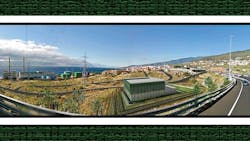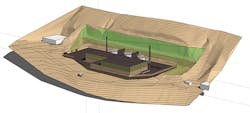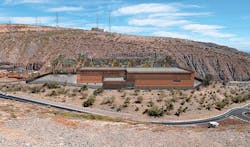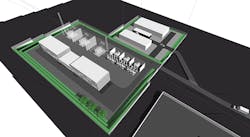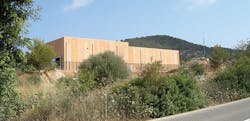Substation Designs Consider Surroundings
The complexity of landscape protection regulations makes it necessary for utilities to consider alternative locations and different finishing options for new substations during the environmental-impact study phase. Presented with these difficulties and the cost of executing several substation projects simultaneously, Red Eléctrica de España (REE) has created a new methodology aimed at developing a series of models, through the use of a location and preliminary draft design, to reduce the visual impact of substations on the landscape.
This methodology makes it possible to adopt criteria that defines the external appearance of substations during a project’s preliminary design phase and draft process to reduce their impact on the landscape. A series of models has made it possible for REE to implement substations in various locations throughout the Iberian Peninsula, Balearic Islands and Canary Islands.
The Methodology
REE’s methodology is applicable to the initial design of a substation’s external appearance and is aimed at reducing the substation’s impact on the landscape. By overcoming the physical, biological and socioeconomic challenges, the impact on the environment can be minimized. The comprehensive approach takes into account that the visual impact of a substation is dependent on five factors:
- Quality of the original landscape
- External appearance
- Visual range affected
- Time when the impact is evaluated
- Sensitivity of the observers. ">
The original landscape factor is a set variable. However, the other four factors are a function of the substation characteristics as well as the relationship with the environment and local inhabitants.
Substations located in a rural environment are extremely difficult, though not impossible, to integrate into the landscape. Similarly, agricultural buildings and warehouses present the same problem; they are frequently integrated into the landscape by incorporating design elements harmonious with the original architecture of the rural buildings in the region. Therefore, to reduce a substation’s impact on the landscape, it must be considered in the same way as that of other rural structures to ensure disharmonious elements are not introduced into the landscape.
There should be an external substation design tailored to every type of landscape. However, because of the large number of landscapes in Spain, estimated to be 1,260, it is not feasible to design a model for every type of landscape. Because of the overall dimensions of a substation, including the access roads and overhead transmission and distribution lines (the tallest linear infrastructures that exist in the landscape), views from space tend to show a large surface area. In practice, these elements are not all perceptible to the same degree. The degree to which they are perceptible depends on the capacity of human sight and the topography, which determines the places from which observers admire the scenery and, thus, the overall visual relationship.
Additional Factors
It is important to stress the visual impact of a substation depends on the time at which it is evaluated. The impact of a substation put into operation in the past is completely different from that of a substation being installed today because society’s perception has changed over time. The sensitivity of potential observers toward the landscape and the substation is a complex factor. The need to conserve the landscape is a product of society appreciating it and not just because of some vision provided by the scientific knowledge of an expert. The impact of the substations in any location depends on each observer’s expectations and the number of observers.
Perceptions of the environment are selective, which is to say that only some elements or aspects in a landscape are deemed important by some but not others. The criteria that govern this selection are difficult to define and unique to each individual’s knowledge; collective experience, aspirations and cultural references; age; and the natural environment to which one is accustomed.
Those who live in a rural environment are accustomed to an agricultural landscape, an ordered landscape in which there are few elements of distortion. On the other hand, city dwellers are more accustomed to a dynamic and varied landscape, the opposite of which would be a boring landscape.
The impact of a substation on the landscape depends on the location, the extent of natural space in the landscape and the significant elements that may change throughout history. The impact also depends on the qualities offered by the landscape with regard to having fun, nature-related education and stimulating the senses, as well as with regard to the cultural heritage of the land and the rest of the attributes that make up the landscape, such as colors, texture and terrain.
To overcome the substation’s impact on the landscape, it is important to analyze the effect that changes to a landscape resulting from establishing a substation might have on people and with respect to how they interact with the landscape. Independent of the perspective by which the landscape is analyzed — aesthetic, ecological or as a place for human activity — in practice, the most important issue is the message the landscape conveys.
REE’s methodology of implementing a series of substation models takes into account the complexity of the landscape factor to improve its integration into the environment. Similar to rural construction, it is based on acting during the early substation design phases so no disharmonious elements are introduced into the landscape.
Landscape Integration Example
Integrating the 220-kV, 250-MVA Caletillas substation into the landscape on Tenerife, an isle in the Canary Islands, was undertaken in three phases:
- Description of the previous landscape
- Description of the proposal
- Criteria and measurements of integration. ">
The value of the landscape around the Caletillas substation is related to its capacity to convey beauty beyond that which can be seen. This landscape is acclaimed for its physical attributes, artistic qualities and psychological connection featured in the landscape. Color is the most important artistic attribute. Human sight easily differentiates between objects thanks to their color. Colors may express feelings and, in this way, may influence human activity while admiring a landscape. Therefore, the visual impact depends directly on color, which may be used to apply preventive or corrective measures for reducing impact by adjusting the tint, tone, brightness or other factors at the same time.
Among the psychological attributes, the relative size of the substation is dependent on the surrounding points of reference. Expression is the most subjective psychological attribute because it influences affectivity. Elements from landscapes usually mentioned for their psychological attributes are historical significance, social use, mythological, religious and spiritual meaning, symbolism and cultural identity.
In the proposal phase, the site-planning and expected landscaping operations are analyzed to envisage the final landscape. For the Caletillas substation, this required a reflexive analysis of the criteria of integration incorporated into the project design with the goal of assessing the impact on the landscape. The main strategies adopted were naturalization and harmonization according to the surrounding environment, and then the step-by-step criteria and landscape-integration measures were performed.
Favorable Response
The methodology established for designing the external appearance of substations constructed by REE has successfully satisfied the utility’s objective to reduce the impact of substations on the landscape and integrate them into the environment. Additionally, the methodology has received positive feedback from the planning authorities responsible for approving the environmental impact assessment.
Different substation models have been designed and used in the environmental impact study procedures, and have been implemented into the different landscapes of Spain. Once a model has been produced for each substation, only minor changes have been required to define and seek approval for the final design.
Santiago Delgado Mateo holds a Ph.D. and an agricultural engineering degree from the Universidad Politécnica de Madrid. Mateo also has a diploma in environmental impact from the Universidad Complutense de Madrid and is an International Master of Irrigation and Drainage from the Ministerio de Agricultura y Medio Ambiente and an International Master in Engineering Valuation and Assessment from the Universidad Politécnica de Valencia. Mateo joined Red Eléctrica de España in 1997. He also works as an associate professor and researcher at the Universidad Politécnica de Madrid.
Luis Cabezón López holds a degree in electrical engineering from the Universidad Politécnica de Madrid. He has been with Red Eléctrica de España since 2003. He started as an electrical engineer and later served as a project manager responsible for coordinating projects with other electrical utilities. Currently, López is responsible for the engineering substations department at Red Eléctrica de España, where he is working on the design and future development of substations for the Spanish grid, including supervisory control and data acquisition (SCADA) and control systems.
Sidebar: Step-by-Step Criteria and Landscape-Integration Measures
Criteria 1. Make the most out of a rundown site
Measure 1: Minimize site leveling to produce a flat surface for the substation.
Measure 2: Provide vegetation in the surrounding environment.
Criteria 2. Make the substation space cohesive with the surrounding environment.
Measure 3: Reduce the dimensions by selecting a gas-insulated substation.
Measure 4: Design the façades with strips that fragment the building.
Measure 5: Use colors for the buildings to harmonize with the surrounding environment.
Measure 6: Replant the perimeter slopes, establish medium-sized plant beds with native species to harmonize the gardens with the surrounding environment and construct walls that look the same as those used in the surrounding agricultural areas.
Measure 7: In the event of broad views as a result of large slopes, consider the roof to be a fifth façade by constructing roofs with stones or cinder from the surrounding area.
Criteria 3. Focus on the view from the highway to the Caletillas substation.
Measure 8: Construct a beautiful, original-looking building.
Measure 9: Plant numerous palm trees between the site and the highway.
Measure 10: Replant the surrounding area with native species, and on the north side (next to the curve in the highway), plant the Canary palm trees or a line of fan palms (Washingtonias).
